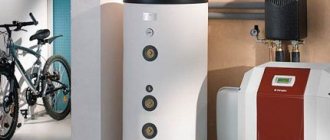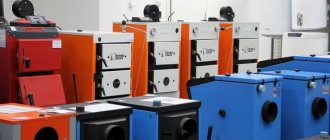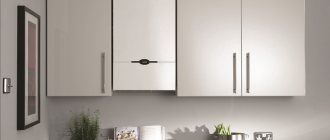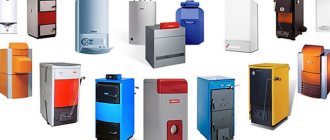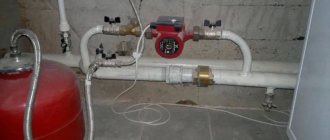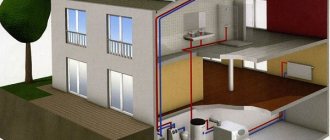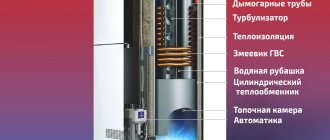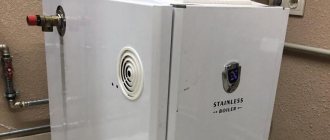Boilers for heating a private house: types, features + how to choose the best. Properly choosing boilers for heating a private house is necessary for installing an autonomous system. It is heating equipment that will provide housing with heat and hot water. It will create the microclimate necessary for human habitation. In addition, it will work flawlessly. It is so?
We will tell you how to buy a boiler that will meet your requirements and wishes. We have analyzed all the criteria that you should pay attention to when looking through catalogs of online stores or an assortment of specialized retail outlets. Problems that you may encounter before and after purchase are listed.
Basic criteria for choosing boilers
Hundreds of foreign and domestic manufacturers offer thousands of models of heating equipment. It is not easy for an unprepared buyer to navigate all this variety of products. I want it to be cheaper and the quality to be high.
All heating boilers differ in the type of fuel and are divided into the following categories:
- solid fuel (processing firewood, peat, pellets, coal);
- liquid fuel (units running on diesel fuel);
- gas (regular and condensing);
- electrical (requiring electricity supply);
- universal (using either gas or electricity).
Before choosing an option, it would be a good idea to do a little analysis and find out which energy carrier is profitable to use in your region. Then you need to decide how safe, reliable and comfortable the boiler should be in terms of every penny invested in it.
You need to choose one or another type of heating equipment after first familiarizing yourself with the advantages and disadvantages of each of them.
In order not to make a mistake and not waste your hard-earned money, you need to carefully consider the process of choosing equipment. To do this, it is necessary to take into account a number of nuances that significantly affect the final result.
When choosing a boiler you should:
- understand in detail the advantages and disadvantages of each type of boiler;
- calculate the optimal heating power for your home;
- decide on the number of circuits;
- choose the location where the equipment will subsequently be placed.
The maximum permissible dimensions and weight depend on the future location of the boiler. After all, for a small room it is not advisable to choose a heavy cast iron unit.
The choice of heating equipment must be approached responsibly. This is the only way to buy high-quality equipment that will last for many years.
What does the market offer?
Below you can watch a video about the variety of types of heating boilers. The selection of boilers is simply incredible in scale. If the user is not a specialist, then it will be very difficult for him not to get lost in the variety of models. But there are a few tips that will help you avoid choosing the wrong boiler:
- If you choose a boiler, you should definitely make sure that it is a branded product. After all, such companies guarantee the quality of their goods.
- Make sure there is a quality certificate.
- Preliminarily evaluate the reviews about a particular boiler model - and it is better if these are reviews from acquaintances and friends.
- Find out if the company that manufactured your new boiler has a service department in your area. After all, in the future you may need maintenance, or even repairs.
The question of choosing equipment, heating in particular, has always been one of the most important. But also difficult. If we consider heating boilers, it is best to do it at a professional level. And if you are going to buy a boiler, be sure to consult with professionals. They will help you make the right choice to avoid problems in the future.
Rules for calculating equipment power
It’s worth remembering right away that the desire to save money on designing a heating system and performing thermal calculations in most cases backfires on the customer. If you think through everything carefully and trust a highly qualified specialist, then the cost of the boiler, radiators and other equipment will be much cheaper.
The power of the heating boiler is selected to calculate the distribution of approximately 0.1 kW per m2 of living space
To approximate the power of heating equipment required to heat a building and provide hot water supply, you can use special design standards.
It is also imperative to take into account:
- the number of people who will live in the house;
- building materials used for housing construction;
- climate zone;
- number of windows and doors;
- number of floors and other factors.
The opinion that the boiler power is selected at the rate of 0.1 kW per square meter is quite common. But thanks to modern building materials and innovative engineering equipment, heat losses can be significantly lower and, accordingly, the performance of heating equipment can be higher.
Characteristics of the main types of boilers
All boiler models offered on the market differ not only in appearance and cost, but also in the fuel used to operate it. They can be divided into separate categories depending on the type of fuel material.
In addition, the energy carrier that will be used to heat water in the heating system plays a big role. It directly affects the efficiency of the boiler, energy efficiency and ease of operation.
Useful qualities of solid fuel boilers
In the CIS countries, solid fuel is considered the most accessible and cheapest. This explains the popularity of equipment that uses this type of energy carrier in its operation.
It should be remembered that you cannot burn everything that burns in a solid fuel boiler. It is necessary to use only the energy carrier for which the equipment was designed.
Boilers intended for solid fuel can only be loaded with firewood, lump peat and coal, but not tires or garbage.
The list of advantages of solid fuel heating equipment should include:
- autonomy;
- good energy efficiency. The efficiency of such boilers approaches that of devices running on fossil fuels (gas, diesel, etc.);
- low energy prices.
When buying solid fuel units, you need to understand that from time to time you will have to add firewood to the boiler. That is, every 6-18 hours it is necessary to fill the boiler with wood fuel or waste from wood processing production structures.
Solid fuel boilers are an outdated design, but today many manufacturers offer decent equipment, the design of which was carried out using modern materials
Operating principle of pellet boilers
Pellets or wood pellets are wood waste compressed into a small cylinder. For example, it could be shavings or sawdust from softwood.
The product is formed without any additional additives or glue; only a pressure of about 300 atmospheres is applied. The diameter of the granules is usually 6-10 mm, and the length is 10-30 mm.
The main advantage of pellet boilers is their autonomous operation. Nowadays, you can easily find equipment with a small bunker, where there is a screw supply of fuel pellets. On average, supplies last for several days.
Often, in order to increase the period of autonomous operation of equipment, another small bunker of a couple of cubic meters is organized in the basement or some outdoor room. From such rooms, fuel pellets are supplied to the bunker and then directly to the boiler.
The pellet boiler is characterized by fairly high efficiency and low consumption of wood pellets. Moreover, this technique is also environmentally friendly.
The disadvantage of such heating equipment is the design complexity of the equipment. Because of this, the pellet boiler is sensitive to the quality of the fuel. In order for the unit to last a long time and to avoid any problems during its operation, it is necessary to use class A or B fuel pellets, which were manufactured by foreign manufacturers.
Another disadvantage of pellet boilers, which prevents their popularization in the domestic market, is their high cost. On average, the price of such devices starts from $2,200.
The installation of a pellet boiler must be carried out taking into account the following requirements:
Pros and cons of liquid fuel boilers
Liquid fuel boilers are considered simple and reliable equipment that, with proper care, will last for decades. They are purchased for installation in country houses and private homes.
The main advantages of this category of boilers:
- no dependence of the equipment on the gas main;
- ease of equipment installation;
- no need to obtain any permits to install the boiler;
- fairly high energy efficiency indicators;
- Some models of diesel boilers can be adapted to operate on gas.
In addition to such obvious advantages, the equipment has certain disadvantages, one of which is the need to heat the fuel line in winter so that the temperature of the energy carrier does not drop below +5 degrees Celsius.
An liquid fuel boiler is the best solution after gas heating equipment if connection to centralized lines is not yet planned, and there is no space to install a gas holder. No approvals are required for the installation and operation of a liquid fuel unit.
Also, the disadvantages of liquid fuel heating equipment include:
- mandatory presence of a compartment designed for fuel storage:
- the equipment creates quite a lot of noise due to the constantly working burner;
- the need to periodically supply high-quality liquid fuel;
- unpleasant odor from the fuel bunker;
- quite high operating costs.
Even despite the large list of disadvantages, liquid fuel equipment is in demand among dacha owners. Especially if access to other energy resources is limited in the area.
The feasibility of purchasing electric boilers
Electric boilers are often installed when the village under construction is not yet equipped with a full-fledged gas network. But subsequently, such units are replaced with gas ones. This use of heating equipment accounts for about a quarter of all sales of electric boilers.
The most common models, whose power is 5-10 kW, can maintain a temperature of about 6 degrees Celsius when it is -20 outside. This is quite enough to continue finishing work in a newly built house.
An electric boiler should only be purchased as a last resort. Due to the high cost of electricity, this type of heating equipment is unprofitable
Distinctive features of electric boilers are the low cost of equipment, ease of installation, small dimensions, lightness, lack of open flame, ease of maintenance and no need to organize a separate room for the unit.
When purchasing such heating equipment, you need to remember the high cost of electricity, the need to connect high-power devices to a three-phase network, and the sensitivity of the device to power outages.
Characteristics of gas equipment
If we compare gas-fired boilers with all other types of heating equipment, then this type is the best choice for most consumers.
After all, gas units are more economical and easier to operate. Such equipment does not require special care, and the process of their operation is fully automated. And you don’t need to store fuel.
When planning to install a floor-standing or wall-mounted gas boiler, you need to know that before installing such equipment you need to obtain the appropriate permit. The certificate is issued by the state regulatory authority.
A gas boiler is the most efficient and economical type of heating equipment if connected to a system of centralized supplies of blue fuel. In the case of using gas holder or bottled gas, economic efficiency is lower
The disadvantages of this type of floor-type heating equipment include the need to install automation, which will shut off the gas pipeline in the event of an energy leak or insufficient ventilation. Also, due to seasonal pressure surges, equipment may fail and require repair.
Although the cost of gas is not too high now, the energy carrier is a fossil fuel. This means that its value could likely increase over time. Therefore, manufacturers are trying to adapt the gas type of boilers to operate on biogas fuel.
For example, on the modern market there are models of equipment that operate without problems on a mixture where about 15% is biogas.
How efficient are universal boilers?
The main advantage of universal heating systems is their convenience. Most often they are installed in those cottage villages where there is no permanent gas supply. People are forced to somehow get out, so they use the gas tank method, the essence of which is to heat the house with liquefied gas.
After the settlement is supplied with a sufficient amount of this energy carrier, the boilers are switched to its use.
Combination units are not practical in areas where intermittent power outages or gas supply interruptions occur
The heating equipment market offers a wide variety of boiler models that use several types of fuel in their operation. A striking example is a system that can burn both gas and liquid fuel.
Its advantage is that, regardless of the type of energy carrier currently used, the thermal output of the boiler will remain virtually unchanged.
Principle of operation
The boiler operates in continuous mode. It is included in the heating circuit and heats the coolant to the highest temperature possible with the existing settings. Then the water flows into a three-way valve, where the hot flow is mixed in a certain proportion with the colder “return”, as a result of which the temperature of the coolant reaches a given value.
The main design element of a gas boiler is the combustion chamber, structurally combined with the primary (main) heat exchanger. Water (coolant) enters it, passes through the coil and is discharged into the secondary heat exchanger (if there is one). As a rule, this is a plate-type flow element used for indirect heating of water for domestic hot water supply.
Smoke and combustion products are discharged outside through a chimney connected to the central chimney of the house or through its own pipe. Most models are equipped with a special fan that stabilizes the draft and at the same time creates conditions for effective smoke removal.
Coolant circulation can occur naturally, but modern boiler models are equipped with circulation pumps. They increase the speed at which the coolant passes through the heating circuit. This reduces the temperature difference between the forward and return lines, which reduces gas consumption for heating.
The operation of the boiler is controlled using an electronic unit, which is connected to an extensive network of sensors. They form a self-diagnosis system that gives a signal when problems occur in a particular unit, element or part. If the problem is serious, an alert appears on the boiler display indicating that there is a problem. If complex and dangerous problems occur, the operation of the boiler is blocked and an error code is displayed on the display.
Some models of gas boilers have a restart function when the problem disappears. For example, if there is no gas in the network, the unit stops. When the standard fuel pressure appears, the boiler operation resumes. This feature allows the owner to leave the house for a while in winter without fear of returning to a room with defrosted pipes.
Features of single- and double-circuit boilers
When thinking about how to choose the right heating boiler for your home, special attention should be paid to such a characteristic as the number of circuits. Single-circuit technology is intended exclusively for heating the coolant circulating through heating pipes.
A single-circuit boiler is designed to serve only one system: either hot water supply or heating. If it is not possible to install a double-circuit unit, it is permissible to use no more than two boilers in one boiler room, regardless of their floor or wall-mounted design
In this case, to heat tap water you will have to additionally install a boiler. Yes, a single-circuit boiler is convenient, but the disadvantage of this solution is its high cost - you will have to buy not only heating equipment, but also a boiler. Moreover, both devices will take up a lot of space.
As for a double-circuit boiler, here the heating equipment and water heater are assembled into a single structure. Thanks to this structure, you can solve two problems at once, while purchasing only one unit.
In addition, in the absence of hot water, the coolant can be redirected to the second circuit and used alternately - to heat the house and to provide hot water supply.
Operating principle of single-circuit equipment
Single-circuit heating equipment is most often used by owners of luxury country houses. In essence, a single-circuit boiler is the same water heater, but supplies water to the heating system.
The operating principle of this type of equipment is based on burning fuel in a special compartment and heating the liquid. The heating main is connected to the outlet where the hot coolant enters. Next, the water begins to circulate through the pipes and heat the rooms.
The final stage of circulation is the flow of waste coolant back into the boiler through the inlet pipeline.
If you do not need to provide hot water supply, then it is better to give preference to single-circuit boilers
The cost of a single-circuit boiler may be more than a double-circuit system. Even despite less functionality, this type of equipment is less expensive to install, easier to operate and more energy efficient.
Single-circuit equipment is suitable for those buyers who want to spend money once and buy reliable equipment that does not require special care. This type of boiler will be the ideal and only right choice when there is no need for hot water supply in the house.
Design specifics of a dual-circuit unit
A double-circuit boiler is a system where, in addition to the primary heat exchanger, there is an additional one designed to heat water and then supply it to the water supply system. The movement of the coolant is controlled using a three-way valve. It directs the heated water either to the DHW circuit or to the heating system.
It should be noted that in the first case, the coolant will be supplied only if the hot water tap has been opened. The peculiarity of such heating equipment is that while the tap responsible for supplying hot water is open, the system does not work.
If you plan to actively consume hot water, then installing a double-circuit boiler is not the best solution. After all, then the house will not be heated well. You should only think about installing this system in a small house or apartment, where there is not enough space to organize a full-fledged boiler room.
In Ozhegov's dictionary
BOILER, -tla, m. 1. Large metal round vessel for heating water and cooking food. Cast iron k. 2. Closed container, device for converting liquid into steam. Steam room 3. transfer. Complete encirclement of the military group. Get to the camp * Common boiler - food, allowances from the common kitchen. The artel has a common boiler. Boil in some kind of cauldron (disapproved) - constantly be in some kind of cauldron. actively operating environment, surroundings. || decrease bowler, -lka, m. (k. 1 value). || adj. boiler room, -aya, -oe (to 1 and 2 values) and boiler room, -aya, -oe (to 1 and 2 values). Boiler installation. Boiler allowance (from a common boiler; official).
Selecting a location for heating equipment
All types of heating boilers are produced mainly in a floor-standing version, electric in a wall-mounted version, and gas in both a wall-mounted and a floor-mounted version. The latest variation is best installed in a spacious separate room. Such heating equipment is characterized by great power and massiveness.
A wall-mounted boiler will be an ideal solution for small-sized houses, where every square meter counts
And due to the fact that the weight of floor-standing boilers is not limited in any way, manufacturers install a cast-iron heat exchanger in it, which is much more reliable than a steel one.
Wall-mounted heating equipment is compact in size and fairly light in weight. But this type of boiler is limited in power. This minus is especially relevant for dual-circuit systems - the performance of the heating circuits will be quite low.
You should choose wall-mounted boilers only if the heated area does not exceed 200 m2 and the hot water consumption is no more than 14 l/min. If the needs are greater, then it is better to give preference to the floor-mounted variation of heating equipment.
It should be noted that many buyers, regardless of the size of their living space, prefer floor-mounted systems that are equipped with a cast-iron heat exchanger. After all, such devices are less demanding on the quality of power supply.
In Vasmer Max's dictionary
genus. p. -tla, ukr. boiler, kind. n. kitla, other Russian, old Slav. kotl χαλκίον, Bulgarian cauldron, Serbohorv. kotao, b. n. kotla, Slovenian kótǝl, Czech. kotel, b. n. kotla, slvts. kotol, Polish kosiоɫ, gen. kotɫa, v.-luzh. kotoɫ, n.-luzh. kóśeɫ. Borrowing to Praslav Gothic era *katils or *katilus (attested form of the genus plural katilē), which comes from Lat. catīnus or catīllus “dish, bowl”; see Bernecker 1, 591; Uhlenbeck, AfslPh 15, 488; Schwartz, AfslPh 41, 125; Bruch, Kretschmer-Festschr. 10 et seq.; Frenkel, ZfslPh 8, 419. Hardly directly from Latin, contrary to Meillet (Ét. 186), Sobolevsky (ZhMNP, 1911, May, p. 163; AflsPh 33, 478); see Kiparsky 203 et seq. Old Balt.-Slav. the origin of the borrowing, contrary to Trautman (ВSW 121), cannot be proven, since lit. kãtilas, Old Prussian katils, lts. katls could be obtained through slav. mediation; see Bernecker, ibid.; M.–E. 2, 171; Buga, “Švietimo darbas”, 1921, No. 5–6, p. 20. From kotelnik came the local. n. Kotelnich, former Vyatsk lips; old the name Koksharov (according to Naumov, Memoir of the Prince of Vyatka Gubernia, 1904, p. 209 et seq.; as quoted in FUF 9, 122). Koksharov is a derivative of kovshar “master who makes ladles, boilers”, from kovsh (see).
